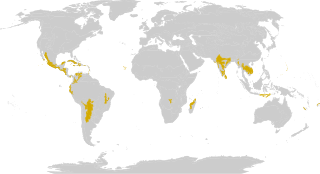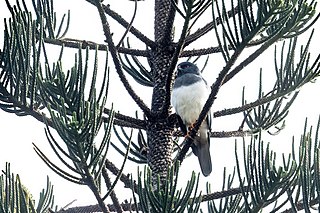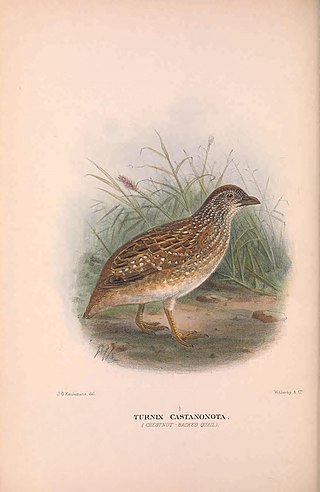
The tropical and subtropical dry broadleaf forest is a habitat type defined by the World Wide Fund for Nature and is located at tropical and subtropical latitudes. Though these forests occur in climates that are warm year-round, and may receive several hundred millimeters of rain per year, they have long dry seasons that last several months and vary with geographic location. These seasonal droughts have great impact on all living things in the forest.

Buttonquail or hemipodes are members of a small family of birds, Turnicidae, which resemble, but are not closely related to, the quails of Phasianidae. They inhabit warm grasslands in Asia, Africa, Europe, and Australia. There are 18 species in two genera, with most species placed in the genus Turnix and a single species in the genus Ortyxelos.

The barred buttonquail or common bustard-quail is a buttonquail, one of a small family of birds which resemble, but are not closely related to, the true quails. This species is resident from India across tropical Asia to south China, Indonesia and the Philippines.

The common buttonquail, also called Kurrichane buttonquail, small buttonquail, or Andalusian hemipode is a buttonquail, one of a small family of birds which resemble but are not closely related to the true quails.

The painted buttonquail is a species of buttonquail, the family Turnicidae, which resemble, but are unrelated to, the quails of Phasianidae. This species is resident in Australia where numbers are believed to be in decline. A subspecies, the Abrolhos painted buttonquail, is endemic to the Houtman Abrolhos islands.

The little buttonquail is a species of buttonquail, part of a small family of birds which resemble, but are unrelated to, the true quails. This species is resident in Australia, where it is one of the more common buttonquails.

The yellow-legged buttonquail is a buttonquail, one of a small family of birds which resemble, but are unrelated to, the true quails. This family is peculiar in that the females are larger and more colourful than the males and are polyandrous.

The buff-breasted buttonquail is the largest and possibly the rarest of the buttonquail. This species is endemic to Cape York Peninsula, in Queensland, Australia.

The black-breasted buttonquail is a rare buttonquail endemic to eastern Australia. As with other buttonquails, it is unrelated to the true quails. The black-breasted buttonquail is a plump quail-shaped bird 17–19 cm (6.7–7.5 in) in length with predominantly marbled black, rufous, and pale brown plumage, marked prominently with white spots and stripes, and white eyes. Like other buttonquails, the female is larger and more boldly coloured than the male, with a distinctive black head and neck sprinkled with fine white markings. The usual sex roles are reversed, as the female mates with multiple male partners and leaves them to incubate the eggs.

The banded quail is a species of bird in the family Odontophoridae. It is found only in Mexico where its natural habitats are subtropical or tropical dry forests, subtropical or tropical dry shrubland, subtropical or tropical high-altitude shrubland, and heavily degraded former forest.

The white-bellied goshawk is a species of bird of prey in the family Accipitridae. It is endemic to New Caledonia. The species is also known as the New Caledonia goshawk or New Caledonia sparrowhawk.

The chestnut-backed buttonquail is a species of bird in the family Turnicidae. It is endemic to Australia.

The Sumba buttonquail is a species of bird in the family Turnicidae. The scientific name commemorates British colonial administrator and zoological collector Alfred Hart Everett.

The black-rumped buttonquail is a small species of bird in the buttonquail family.

The red-backed buttonquail is a species of bird in the family Turnicidae. It is found in Australia, Indonesia, Papua New Guinea, the Philippines and the Solomon Islands. Other names by which it is known in different parts of its range include black-backed, black-spotted and orange-breasted buttonquail. There are fourteen recognised subspecies.

The Madagascar buttonquail is a species of bird in the buttonquail family, Turnicidae, that is endemic to Madagascar and a few small islands nearby. It is a ground-dwelling species with an unusual breeding biology in which the sexual dimorphism is reversed, with female being more brightly coloured than the male and it is the male that incubates the eggs and mainly cares for the young.

The red-chested buttonquail is a species of bird in the family Turnicidae. It is endemic to Australia. The species is generally regarded as widespread, although uncommon, in New South Wales, Queensland, northern Western Australia and the Northern Territory, and classified as Vulnerable in Victoria.
The Luzon buttonquail or Worcester's buttonquail, is a species of bird in the family Turnicidae. It is endemic to the island of Luzon in the Philippines. Its natural habitat is subtropical or tropical high-altitude grassland. It is locally known as "Pugo". It is a cryptic species and not easy to observe and is listed as "Data Deficient" by the IUCN.

The Fynbos buttonquail is a bird in the family Turnicidae formerly considered conspecific with the black-rumped buttonquail. There are no subspecies.

















